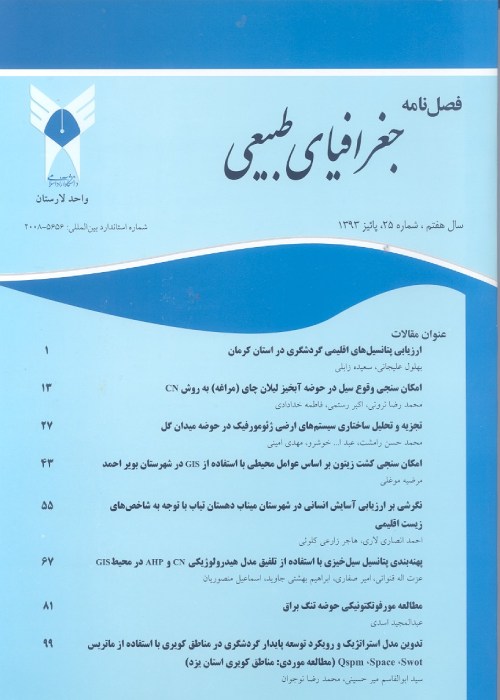Investigation of Climate Change on the Southern Coastal of the Caspian Sea Using SDSM, LARS-WG and Artificial Neural Network
Author(s):
Abstract:
Introduction
Average surface temperatures of the Northern Hemisphere have risen in response to climate change by 0.76°C over the past 150 years (IPCC, 2007) .These temperature increases have been accompanied by a reduction in snow and ice cover, retreat of sea ice and mountain glaciers, a longer growing season and earlier arrival of spring, increased frequency of extreme rainfall events, and more than 25,000 other changes in physical and biological indicators of global warming (Rosenzweig et al., 2008). Numerical models have used in such research after the late of year 1970s. The downscaling software such as SDSM,LARS_WG and ANN (Artificial Neural Network) became very common in the recent decades(e.g. Khan, et al., 2006).The results have showed that the SDSM is the most capable of reproducing various statistical characteristics of observed data in its downscaled results with 95% confidence level, the ANN is the least capable in this respect, and the LARS-WG is in between SDSM and ANN. According to Lopes et al (2008) in Assessment of climate change in Lisbon, the SDSM tool was able to better represent the minimum and maximum temperature whereas LARS-WG simulations is slightly better for precipitation.Material and
Methods
This research has used downscaled methods for the minimum and maximum temperatures of five stations including Anzali, Rasht, Babolsar, Ramsar and Gorgan in the southern coastal of the Caspian sea by three models namely LARS-WG, SDSM and ANN during 1961-90 and 2010-2039 period under three scenarios of A1 , A2 , And B2 . For this purpose, first the observed data of 1961-90 period were obtained from Meteorological Organization of Iran. Since GCMs are restricted in their usefulness for local impact studies with their coarse spatial resolution (typically 50,000 km2) and inability to resolve important subgrid scale features such as clouds and topography, the three downscaling models namely SDSM, LARS_WG and ANN were used to downscaling these coarse data. Two GCM data were obtained from the website: http://www.cics.uvic.ca/scenarios/index.cgi?Scenarios. Root Mean square error (RMSE), Mean absolute error (MAE) and Coefficient of determination ( ) were used to assessing the capability of the models.Result and
Discussions
SDSM model results showed very small error ( 0.01 to 0.06°C) between observed and generate data using NCEP predictors-based data with a little more discrepancy using HADCM3 predictors-based data . The model output showed minimum and maximum temperature will rise during the future period with the exception of the months including April ,May and November. This warming trend was same for ANN with error range of 0.2 to 0.8°C. LARS-WG simulation showed temperature will rise for all months of the year with the error range of 0.1 to 0.2°C. The comparison betweem three models showed that the SDSM tool was able to better represent the minimum and maximum temperature.Conclusion
According to this study the temperature increased during the target period. Temperature will increase during future period too.The SDSM and ANN model showed decrease in the temperature of the months including April, May and November. But the LARS_WG showed increase in the temperature in all month and all stations. The comparison of the models showed that the SDSM model has recorded the lowest error in the predicting of future temperatures. Keywords:
Language:
Persian
Published:
Journal of Physical Geography, Volume:9 Issue: 34, 2017
Pages:
23 to 41
magiran.com/p1707945
دانلود و مطالعه متن این مقاله با یکی از روشهای زیر امکان پذیر است:
اشتراک شخصی
با عضویت و پرداخت آنلاین حق اشتراک یکساله به مبلغ 1,390,000ريال میتوانید 70 عنوان مطلب دانلود کنید!
اشتراک سازمانی
به کتابخانه دانشگاه یا محل کار خود پیشنهاد کنید تا اشتراک سازمانی این پایگاه را برای دسترسی نامحدود همه کاربران به متن مطالب تهیه نمایند!
توجه!
- حق عضویت دریافتی صرف حمایت از نشریات عضو و نگهداری، تکمیل و توسعه مگیران میشود.
- پرداخت حق اشتراک و دانلود مقالات اجازه بازنشر آن در سایر رسانههای چاپی و دیجیتال را به کاربر نمیدهد.
In order to view content subscription is required
Personal subscription
Subscribe magiran.com for 70 € euros via PayPal and download 70 articles during a year.
Organization subscription
Please contact us to subscribe your university or library for unlimited access!


